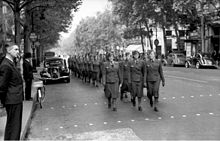
Wehrmachthelferin was the name for girls and young women who served during the Second World War with the German Wehrmacht as auxiliaries.[1][2]

Wehrmachthelferin was the name for girls and young women who served during the Second World War with the German Wehrmacht as auxiliaries.[1][2]
In the beginning, women in Nazi Germany were not involved in the Wehrmacht, as Adolf Hitler ideologically opposed conscription for women,[3] stating that Germany would "not form any section of women grenade throwers or any corps of women elite snipers."[4] However, with many men going to the front, women were placed in auxiliary positions within the Wehrmacht, called Wehrmachtshelferinnen (transl. Female Wehrmacht helpers),[5] participating in tasks such as:
They were placed under the same authority as Hiwis, auxiliary personnel of the army (German: Behelfspersonal) and they were assigned to duties within the Reich, and to a lesser extent, in the occupied territories, for example in the general government of occupied Poland, in France, and later in Yugoslavia, in Greece and in Romania.[6]
By 1945, 500,000 women were serving as Wehrmachtshelferinnen, half of whom were volunteers, while the other half performed obligatory services connected to the war effort (Kriegshilfsdienst).[5]